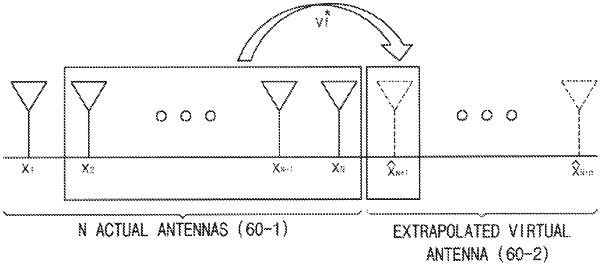| CPC G01S 7/354 (2013.01) [G01S 13/42 (2013.01); H01Q 3/40 (2013.01); G01S 7/356 (2021.05)] | 15 Claims |

|
1. A method of estimating a direction of arrival (DOA) of a radar reception signal using antenna array extrapolation, including:
generating a plurality of virtual reception signals, each of the virtual reception signals being generated by: (i) obtaining a transformation matrix which represents a relationship between phases of reception signals received through ith to (N−2+i)th antennas and a phase of a reception signal received through (N−1+i)th antenna in a uniform linear array (ULA) antenna unit in which N antennas are arranged in a row and spaced apart by a distance d, where i is a natural number having an initial value greater than 1 and N is a count of antennas in the ULA, N having a value that is greater than the initial value of i; (ii) generating a phase of a virtual reception signal received through a new (N+i)th virtual antenna by multiplying values corresponding to phases of the reception signals received through (i+1)th to (N−+i)th antennas by the obtained transformation matrix; and (iii) obtaining a magnitude component of the virtual reception signal received through the (N+i)th virtual antenna by averaging magnitudes of the reception signals received through ith to (N−1+i)th antennas, wherein the steps of obtaining the transformation matrix, generating the phase of the virtual reception signal, and obtaining the magnitude component of the virtual reception signal are performed iteratively for each of the plurality of virtual reception signals, while the number i is being increased, until the number i becomes equal to a predetermined threshold value M, the threshold value M being greater than the initial value of i; and
using the virtual reception signals to detect a direction of arrival (DOA) of a target.
|